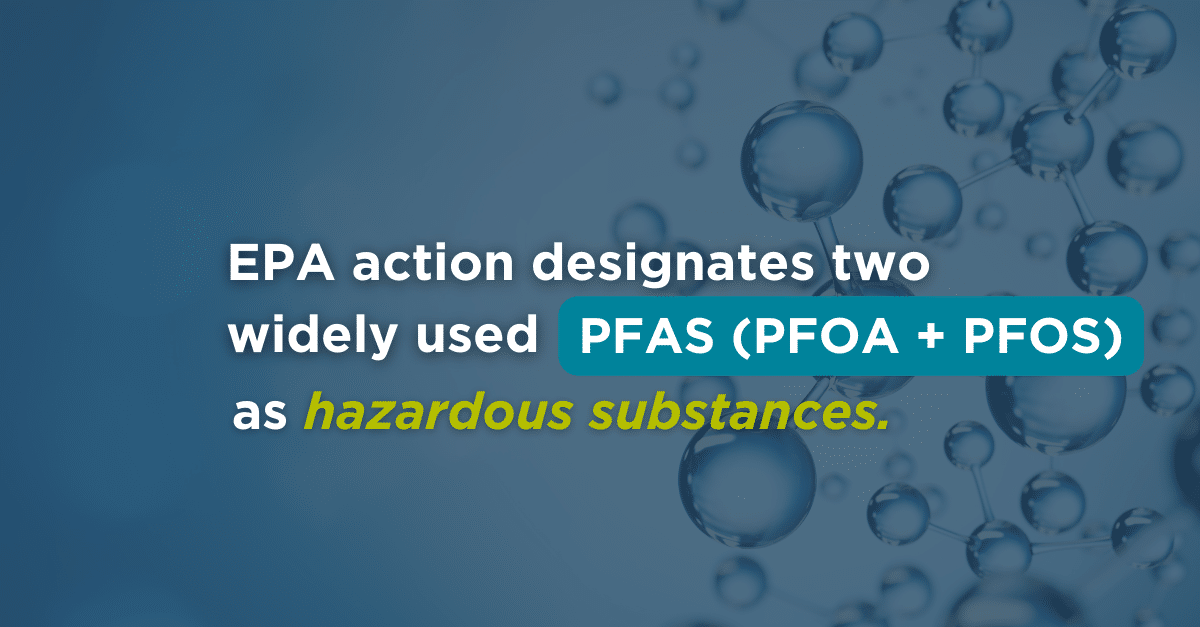April 24, 2024

The US Environmental Protection Agency (EPA) has made recent announcements and regulations to safeguard communities from PFAS chemicals. Learn more about PFAS.
EPA’s New CERCLA Hazardous Substance Designation of PFOA and PFOS: A Closer Look
On April 19, 2024, the EPA announced a newly finalized rule that represents a step towards the nationwide reduction of PFAS contamination. Two widely used PFAS chemicals, perfluorooctanoic acid (PFOA) and perfluorooctanesulfonic acid (PFOS), will be designated as hazardous substances under the Comprehensive Environmental Response, Compensation, and Liability Act (CERCLA), also known as Superfund. EPA is taking this step to designate PFOA and PFOS under CERCLA because both chemicals meet the statutory criteria for designation as hazardous substances. Significant impacts of the Rule may include:
- Requests for sampling and testing for PFOA and PFOS at existing Superfund sites.
- Potential reopening of existing Superfund sites, if EPA determines that previously completed remedial actions are no longer protective of human health and the environment.
- The designation of PFOA and PFOS as CERCLA hazardous substances means that those chemicals will need to be considered as part of a Phase I Environmental Site Assessment under ASTM Standard E1527-21 for purposes of meeting the “All Appropriate Inquiries” standard.
- Persons in charge of a vessel or facility, with knowledge of a release of PFOA/PFOS above the reportable quantity (RQ), will need to immediately report such releases to the federal, state, tribal, and local authorities. The RQ for PFOA/PFOS is 1 pound or greater. Once EPA has collected more data on the extent of releases and the resulting risks to human health and the environment, EPA may consider issuing a regulation adjusting the reportable quantities for these substances.
- Facility owners/operators will be required to notify their local emergency planning committee (LEPC), State Emergency Response Commission (SERC), or Tribal Emergency Response Commission (TERC) likely to be affected by a release under section 304 of the Emergency Planning and Community Right-to-Know Act (EPCRA).
- Increased costs at sites that are currently being studied and remediated if parties are required to address PFOA and PFOS impacts.
What’s Next?
- The rule is effective as of July 8, 2024.
- Potentially affected entities should be proactive and prepared.
- Companies should analyze historical information about where and when PFOS and PFOA were used in operations to understand the scope of potential contamination.
- Companies that are tasked with cleaning up PFOA/PFOS contamination should be aware of EPA’s recently updated Interim Guidance on the Destruction and Disposal of PFAS and Materials Containing PFAS.
Who is impacted by the Rule?
- Manufacturers of PFOA or PFOS or products with these substances
- PFOA/PFOS processors
- Downstream PFOA/PFOS users
- Waste management facilities
- Wastewater treatment facilities
- Owners of properties where PFOA and PFOS contamination is or could be identified
Other potentially affected groups include, but are not limited to, the following:
- Oil and Gas Extraction
- Mining
- Utilities (Water and Sewage Systems)
- Textile Mills
- Paper Manufacturing / Printing
- Chemical Manufacturing
- Plastics and Rubber Manufacturing
- Metal Manufacturing
- Computer and Electronic Product Manufacturing
- Rail and Truck Transportation
- Waste Management Services
- Aviation operations
- Operations that use polymers, photographic film material, pesticides, and some medical devices
- Firefighting training facilities
Insurers, investment firms, and private equity firms should consider the potential liabilities relating to real estate transactions under the Rule.
Contact Us
S&ME understands the technical and regulatory aspects of PFAS and intricacies to evaluate and implement the most effective PFAS strategy for clients. Read more.
For more information, please contact Vince Epps.
